Ants in florida
Pest Library
While not every ant species in South Florida is destructive or delivers painful bites, these tiny pests still have the potential to disrupt your day. Ants can be a significant problem in Florida due to our warm and humid weather. Learn all about ants and how to identify them here, and use the button above to get in contact with us to help remove and prevent ants in your home or business!
HOW TO GET RID OF ANTS
You should only address visible ants after you’ve identified their food source, water source, or colony, especially when using ant and roach sprays. The ants you see are colony workers, tasked with finding and transporting food. Spraying these ants might kill a few, but thousands more will replace them.
By tracing their route into your home, you can likely identify the food scraps or garbage they’re feasting on. The first step is to remove this food source. Tracing the path in the opposite direction may lead you to their entry point into your home and possibly their colony mound. Then, you should take the following actions:
- Set up ant bait outside your home – This won’t immediately eliminate all ants, but the bait will serve as a food source that should deter them from entering your house. If they manage to transport enough back to the colony, it could potentially eradicate the entire colony.
- Implement exclusionary control – This involves sealing the crack or gap that allowed the ants to enter your home. If an open door or window was the issue, closing it could resolve the problem, but it’s advisable to keep them closed as much as possible until the issue is resolved.
- Consider treating the nest – If the ants are non-stinging, you might be able to treat them with a mixture of boiling water and a carbaryl-based insecticide. These are typically granular, so exercise caution if the nest is in an area frequently used by children or pets, as they could be harmed by ingesting these chemicals.
Read more about identifying and getting rid of ants. If after following these steps, you still find ants in your house, contact an ant control professional for help.
Ghost Ants

What do ghost ants look like?
Ghost ants are our number-one nuisance ant found in homes and structures. Ghost ants are tiny ants, approximately 1/16” in length. Their head and thorax are dark and their abdomen and legs are light, almost translucent. This coloration and their small size make them hard to see and earns them their ghostly name.
When are ghost ants most active?
In Southern Florida and other warm areas, ghost ants remain active all year.
What attracts ghost ants?
Indoors they are attracted to food, moisture, and warmth. They are especially attracted to foods that are sweet, high in protein, or greasy, such as sweet drinks, syrups, and food crumbs. They may even infest packages of these foods if accessible. They’re also attracted to moist areas with access to water, such as bathrooms, basements, greenhouses, kitchens, or leaky appliances.
Where are you likely to find ghost ants?
These ants move quickly in a line following their own odor trail and gain entry to interiors through crevices around doors, windows, utility pipes, and wire entry areas. Foragers are often seen indoors on sinks, counters, and floors of kitchens and bathrooms but they are not restricted to those areas. They often move throughout a building via wires in wall voids and under edges of carpeting. Their indoor nests can be in wall voids, between and behind cabinets, and in potted plants. Nests have even been found in spaces between books, folded clothes, and behind loose edges of wallpaper.
Are ghost ants dangerous or destructive?
No, ghost ants are not dangerous or destructive ants. They are considered a nuisance pest, but they could pose a potential threat to human health by contaminating food.
White-footed Ants
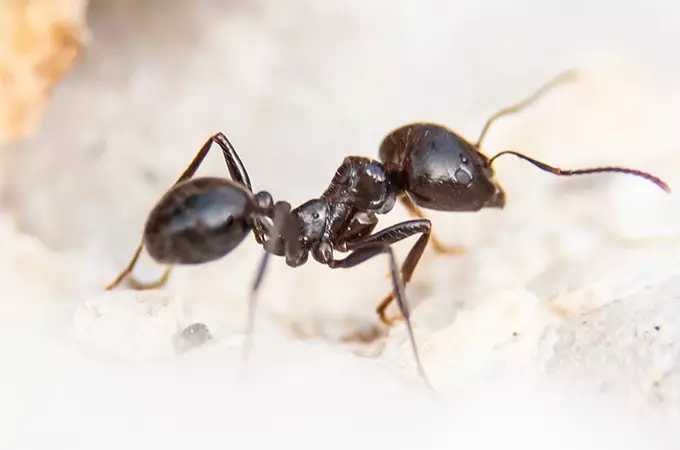
What do white-footed ants look like?
White Footed Ants are very small, typically 1/8”. This black-to-brownish-black ant has yellowish-white feet and a one-segmented waist.
When are white-footed ants most active?
White-footed ants are most active during Florida’s rainy season. As the plants are growing, the piercing-sucking insects on the plants are producing more honeydew. Honeydew is the sugary substance produced by some plants. This is a major food source for the white-footed ants.
What attracts white-footed ants?
This type of ant is strongly attracted to sweet foods. They will also feed on dead insects and other proteins. Honeydew produced by ornamental pests is one of their favorite foods, so it’s best to have a professional check your ornamentals for these pest producers.
Where are you likely to find white-footed ants?
White-footed ants are typically arboreal, which means they nest above the ground. These ants tend to gather on structures and on the edges of exterior wall panels and cables. They will eventually find a few small openings to the interior of the structure and find their way into kitchens and bathrooms where liquid and sweet substances can be found. They can also be found in wall voids, attics, or under roof shingles.
Are white-footed ants dangerous or destructive?
White-footed ants do not bite or sting, nor have they been reported to cause any structural damage. They’re considered a nuisance pest in Florida because they forage in kitchens, bathrooms, and the exterior of buildings. Their large colonies can also be difficult to control.
Bigheaded Ants
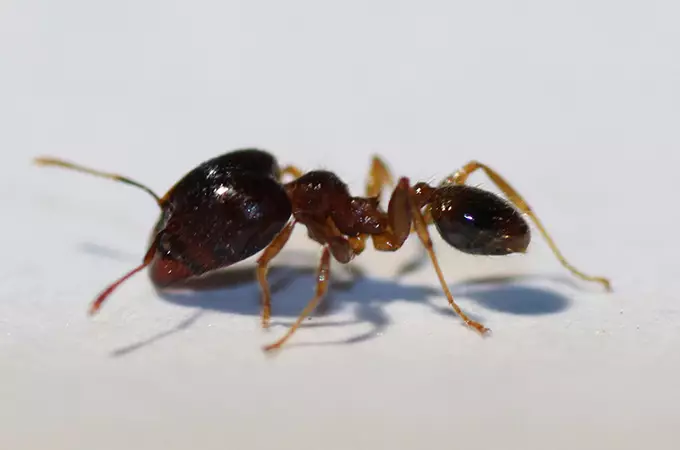
What do bigheaded ants look like?
Bigheaded ants are very small, roughly 1/8”. They vary in color from shades of red, brown, or light yellow. There are 2 distinctive sizes (1/8” to 1/4”) which represent the minor and major workers. The minor workers’ body regions are proportionate in size whereas the major workers’ heart-shaped head is disproportionately larger than the rest of the body.
When are bigheaded ants most active?
Bigheaded ants are active 10 months out of the year. They can withstand some of the colder months here in Florida better than most other ants because they nest underground. During the months of January and February, they are less active because there is a limited food source. They tend to swarm during mating season in mid-summer.
What attracts bigheaded ants?
Indoors, bigheaded ants will feed on fats, meats, and oily foods such as peanut butter and sweet foods. Like White Footed Ants, they also love honeydew.
Where are you likely to find bigheaded ants?
Bigheaded ants are typically pests that live on the lawn and on the plant beds of a garden. You won’t typically find them inside. Bigheaded ants may be seen trailing along the edges of foundations, driveways, sidewalks, and other structural guidelines. They may construct mud tubes on foundations and other structures protecting their trails and entry areas. The tubes may be mistaken for termite mud tubes but are more fragile. Indoors, these ants may be seen trailing along baseboards and under carpet edges. Often these trails are from outdoor nests.
Are bigheaded ants dangerous or destructive?
Bigheaded ants are generally not a threat to your health or property. They are considered a nuisance pest. As an invasive species in Florida, they pose a threat to native ants and other insects and can displace native fauna. Left unchecked, they could also cause property damage over time.
Black Crazy Ants
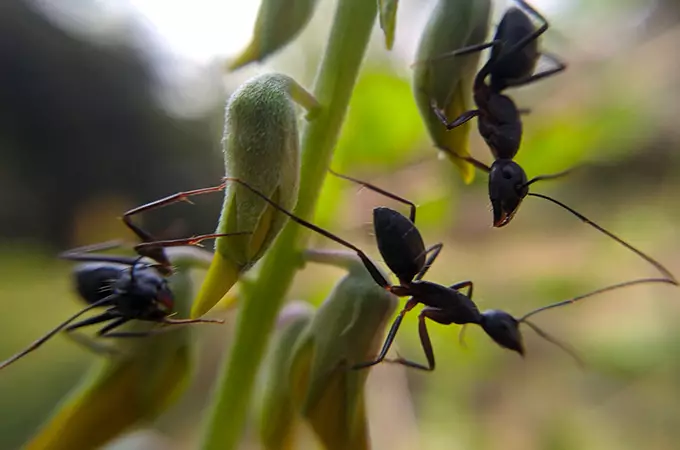
What do black crazy ants look like?
Black crazy ants are uniformly dark brown to black and are about 1/8″ in length. Upon close inspection, they have longer legs and antennae than other ants their size.
When are black crazy ants active?
Because of Florida’s mild weather, black crazy ants remain active all year.
What attracts black crazy ants?
Crazy ants can utilize household food sources that are either greasy or sweet like honey, fruit, meats, and grease. These ants can completely cover food in a very short period of time.
Where are you likely to find black crazy ants?
With black crazy ants, you typically find them outside, nesting in mulch, rocks, and leaf litter. Foragers access buildings on the ground or over branches touching the structure and enter through holes or exterior cracks around windows and doors. Indoors, they may be seen foraging along baseboards and carpet edges with trails up to a hundred feet long. They have loose, unorganized trails, and when disturbed, run erratically with no apparent direction (where their “crazy” name came from). Inside, they may be nesting in wall voids or cracks, kitchen cabinets or storage areas, or in potted plants.
Are black crazy ants dangerous or destructive?
Black crazy ants are not dangerous or destructive ants. They are a nuisance pest. However, if left unchecked they can cause damage to electronics.
Caribbean Crazy Ants
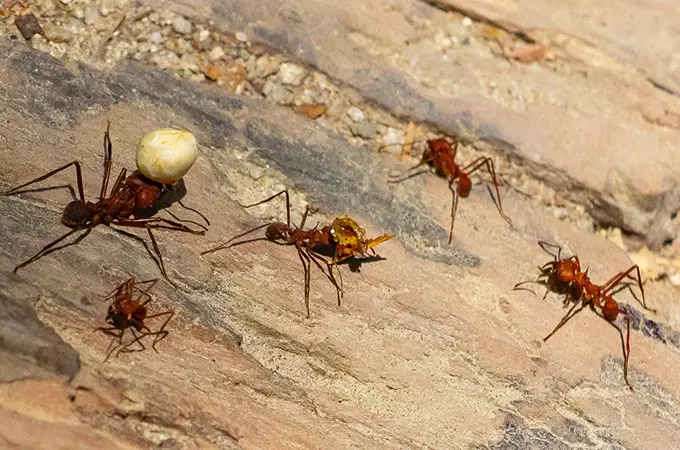
What do Caribbean crazy ants look like?
Caribbean crazy ants are golden-brown to reddish-brown in color. Their body surface is smooth and glossy. They are named “crazy” due to their swift and erratic movements.
When are Caribbean crazy ants active?
Caribbean crazy ants are active year-round but have not been observed outside their nests in temperatures below 60 degrees Fahrenheit.
What attracts Caribbean crazy ants?
It is assumed that Caribbean crazy ants feed on dead insects and honeydew from whiteflies and other insects. They are attracted to moisture, electrical equipment, and warm, enclosed spaces.
Where are you likely to find Caribbean crazy ants?
A new ant to Florida, Caribbean crazy ants have only been observed in recent years. Researchers believe this pest entered Florida via cargo in the Port of Miami and the Port of St. Lucie where the first infestations were found. You are likely to see large numbers of Caribbean crazy ants traveling along sidewalks, in shrubs, and around buildings. It’s also common to find them emerging from soffits and underground electrical conduits.
Are Caribbean crazy ants dangerous or destructive?
Caribbean crazy ants do not bite or sting. They are considered a nuisance pest in part because they travel in groups numbering in the thousands. They can cause damage to the structure of houses, contaminate food, and are known to invade electrical circuits. Being an invasive species, they can disrupt the native ant species.
Florida Carpenter Ants
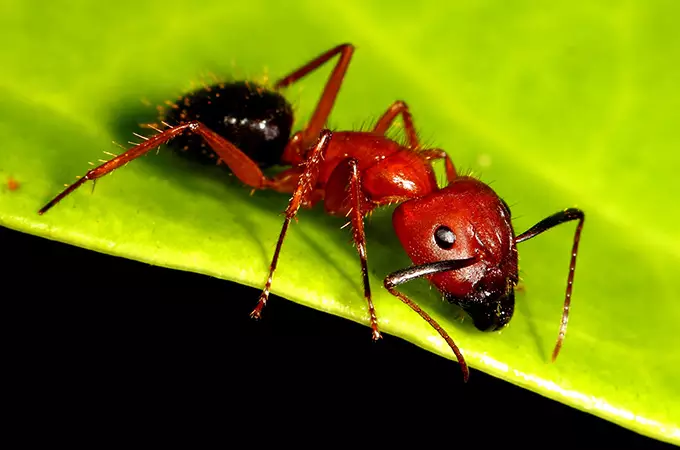
What do carpenter ants look like?
The head, thorax, and body of carpenter ants are reddish to orange. They have a black front body section. These ants are fairly large and range in size from 1/5″ to 1/2″ in length. Note: Due to their similarities with termites, professional identification is highly recommended.
When are carpenter ants most active?
Carpenter ants are a year-round pest problem. Carpenter ant colonies produce male and female swarmers (ants with wings) that take flight in the spring. The timing and number of flights within a season varies by species.
What attracts carpenter ants?
Carpenter ants in Florida are highly attracted to damaged wood. They do not eat wood, but they tunnel through it to create nests and galleries for their colonies. They’re attracted to sweets such as sugary sodas, food, garbage, or pet food. They also eat dead or living insects and honeydew produced by other insects.
What are the signs of a carpenter ant infestation?
Signs of a Carpenter ant infestation are small piles of “sawdust” which are produced from their nest excavations. Usually, these piles are near a nest. They may also contain bits of dead ants and other insects. If bits of insulation foam are seen in the piles, it may be a sign of nests in structural foam elements.
Are carpenter ants dangerous or destructive?
Carpenter ants do not eat wood but rather excavate it to form galleries for nesting. These ants can be destructive and should be treated by a professional. Learn more about how Nozzle’s home pest control services can get rid of Florida carpenter ants.
Fire Ants
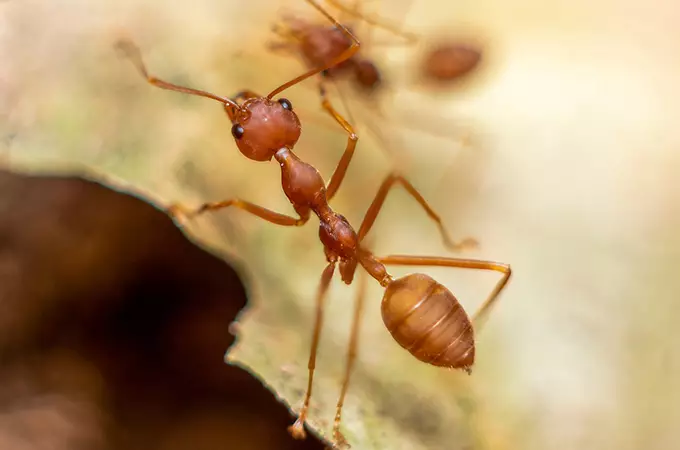
What do fire ants look like?
Fire ant colonies contain workers of different sizes ranging from 1/8″ to 1/4″ in length. They are generally uniform in color and are dark brown to red.
When are fire ants most active?
In Florida, fire ants are active all year long. They swarm several times a year between spring and fall. Fire ants prefer to nest in open, sunny areas, which is why they are often found in yards.
What attracts fire ants?
These ants are attracted to warm, humid environments with annual rainfall of 10” or more. They eat fruits, sugars, and syrups as well as other insects and meat. Fire ants also consume grease and other lipids. They are attracted to moist environments such as leaking pipes, humid basements, bathrooms, kitchens, and laundry rooms.
What are the signs of a fire ant infestation?
The most recognizable sign of a fire ant infestation is the dome-shaped mounds they create in the ground and the protective behavior of workers who pour out of disturbed mounds to attack and sting intruders. AVOID THESE MOUNDS and call a professional immediately for treatment.
Are fire ants dangerous or destructive?
People, pets, and other animals who unknowingly disturb their mounds can be quickly covered with stinging ants. Significant illnesses and deaths have occurred from allergic reactions to their venom. Fire ant venom is unique in the insect world as it produces an immediate and painful stinging, burning sensation. Later, white pustules will form on the skin at the site of the sting. If you see a dome-shaped mound in your yard, avoid it and call a professional as soon as you can to get it safely taken care of.
SEEK MEDICAL ATTENTION IMMEDIATELY IF SEVERE ALLERGIC REACTION OCCURS.